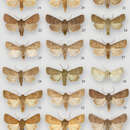Protorthodes mulina
(
Inglês
)
fornecido por wikipedia EN
Protorthodes mulina is a moth in the family Noctuidae first described by William Schaus in 1894. It probably has a wide range in Mexico, occurring as far south as the state of Chiapas, but is known from very few localities. In the United States it occurs from western Texas to southeastern Arizona.
The length of the forewings is 13–17 mm. The ground color of the forewings is orange or yellow orange with darker orange-brown lines. Adults are on wing in May and June and again from mid-August to early November, probably in two generations.[1]
References
-
^ Lafontaine, J.D.; Walsh, J.B.; Ferris, C.D. 2014: A revision of the genus Protorthodes McDunnough with descriptions of a new genus and four new species (Lepidoptera, Noctuidae, Noctuinae, Eriopygini). ZooKeys, 421: 139-179. doi:10.3897/zookeys.421.6664

- licença
- cc-by-sa-3.0
- direitos autorais
- Wikipedia authors and editors
Protorthodes mulina: Brief Summary
(
Inglês
)
fornecido por wikipedia EN
Protorthodes mulina is a moth in the family Noctuidae first described by William Schaus in 1894. It probably has a wide range in Mexico, occurring as far south as the state of Chiapas, but is known from very few localities. In the United States it occurs from western Texas to southeastern Arizona.
The length of the forewings is 13–17 mm. The ground color of the forewings is orange or yellow orange with darker orange-brown lines. Adults are on wing in May and June and again from mid-August to early November, probably in two generations.
- licença
- cc-by-sa-3.0
- direitos autorais
- Wikipedia authors and editors
Protorthodes mulina
(
Neerlandês; Flamengo
)
fornecido por wikipedia NL
Insecten Protorthodes mulina is een vlinder uit de familie van de uilen (Noctuidae).[1] De wetenschappelijke naam van de soort is voor het eerst geldig gepubliceerd in 1894 door Schaus.
Bronnen, noten en/of referenties Geplaatst op:
12-04-2013
Dit artikel is een beginnetje over biologie. U wordt uitgenodigd om op bewerken te klikken om uw kennis aan dit artikel toe te voegen.

- licença
- cc-by-sa-3.0
- direitos autorais
- Wikipedia-auteurs en -editors
Protorthodes mulina
(
Vietnamita
)
fornecido por wikipedia VI
Protorthodes mulina là một loài bướm đêm trong họ Noctuidae.[1][2]
Chú thích
-
^ Bisby F.A., Roskov Y.R., Orrell T.M., Nicolson D., Paglinawan L.E., Bailly N., Kirk P.M., Bourgoin T., Baillargeon G., Ouvrard D. (red.) (2011). “Species 2000 & ITIS Catalogue of Life: 2011 Annual Checklist.”. Species 2000: Reading, UK. Truy cập ngày 28 tháng 6 năm 2014.
-
^ Beccaloni, G. W., Scoble, M. J., Robinson, G. S. & Pitkin, B. (Editors). (2003) The Global Lepidoptera Names Index (LepIndex). (Geraadpleegd maart 2013).
Liên kết ngoài
- licença
- cc-by-sa-3.0
- direitos autorais
- Wikipedia tác giả và biên tập viên
Protorthodes mulina: Brief Summary
(
Vietnamita
)
fornecido por wikipedia VI
Protorthodes mulina là một loài bướm đêm trong họ Noctuidae.
- licença
- cc-by-sa-3.0
- direitos autorais
- Wikipedia tác giả và biên tập viên
Description
(
Inglês
)
fornecido por Zookeys
Protorthodes mulina is easily recognized by the orange or yellow-orange ground color of the forewing with the maculation defined by darker orange-brown lines, and especially by the enlarged lower lobe of the reniform spot that is filled with a dark blue gray. Forewing length varying from 13 to 17 mm. The male and female genitalia are divergent from other species in the genus, although several features suggest a relationship to the Protorthodes incincta group; the vesica has a basal cornutus, the subbasal diverticula in the vesica are similar to those of species in the Protorthodes incincta group, but in Protorthodes mulina these structures are much larger than those of other species in the Protorthodes incincta group and the vesica is about twice as long. Unique features of the male genitalia are the enlarged, rounded cucullus, wider than the valve, unlike other species of Protorthodes, the clasper is almost straight with an abrupt 90°bend near the apex, and the digitus is reduced, lying entirely along the inner surface of the valve with the apex slightly expanded and forked. The female genitalia, like other species in the Protorthodes incincta group, has an amorphous sclerotized mass on the posterior part of the ductus bursae; the position and shape of the lobes of the corpus bursae are unique.
- licença
- cc-by-3.0
- direitos autorais
- J. Donald Lafontaine, J. Bruce Walsh, Clifford D. Ferris
- citação bibliográfica
- Lafontaine J, Walsh J, Ferris C (2014) A revision of the genus Protorthodes McDunnough with descriptions of a new genus and four new species (Lepidoptera, Noctuidae, Noctuinae, Eriopygini) ZooKeys 421: 139–179
- autor
- J. Donald Lafontaine
- autor
- J. Bruce Walsh
- autor
- Clifford D. Ferris
Distribution
(
Inglês
)
fornecido por Zookeys
Taeniocampa mulina: syntypes in USNM, examined. Type locality: Mexico, [Veracruz], Jalapa. Hyssia pseudochroma: holotype ♂, USNM, examined. Type locality: Mexico, [Veracruz], Zacualpan.
- licença
- cc-by-3.0
- direitos autorais
- J. Donald Lafontaine, J. Bruce Walsh, Clifford D. Ferris
- citação bibliográfica
- Lafontaine J, Walsh J, Ferris C (2014) A revision of the genus Protorthodes McDunnough with descriptions of a new genus and four new species (Lepidoptera, Noctuidae, Noctuinae, Eriopygini) ZooKeys 421: 139–179
- autor
- J. Donald Lafontaine
- autor
- J. Bruce Walsh
- autor
- Clifford D. Ferris

